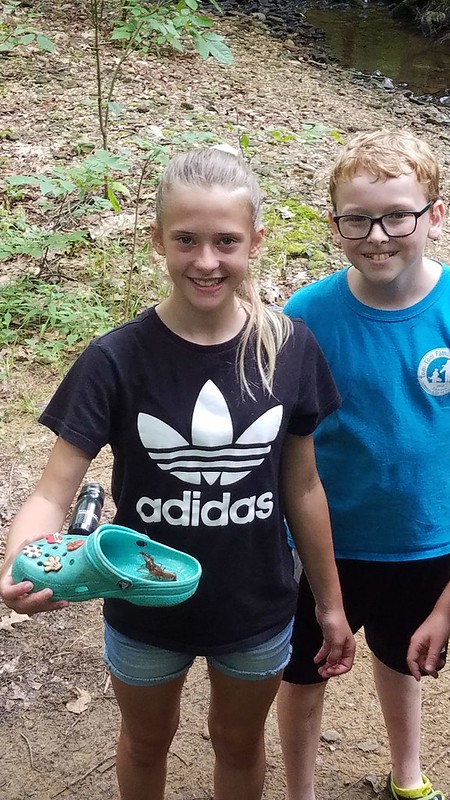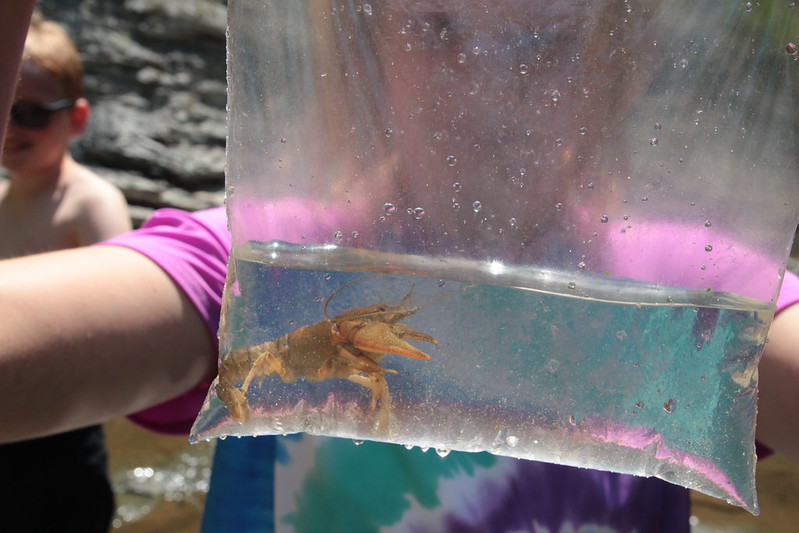Last summer, I took a group of 10 – 14-year-olds on a day trip to hike the Minister Creek Hiking Trail in Allegheny National Forest. When we arrived, and before any hiking began, I led them to a clearing by a creek where we were planning on having snack. Very little of their food was eaten before the questions began.

First question, can we go explore the creek? Yes. Second question, can I take my shoes off? Yes. Third question, can I get in the creek? Yes. Fourth question, a few minutes later and at a much higher volume, can you hand me my shoe?! I need it to hold something! Okay… wait, what are you putting in your shoe?
I stood up and walked to the stream. By the time I arrived, the shoe had already been delivered, and inside the blue Croc was now a crayfish. Soon we were finding more and more crayfish and our hike became an afterthought. I was more than happy to scrap the original plan and honestly when working with kids and teens, especially in nature, it’s more than a possibility. It’s an expectation.
You may know crayfish by another name, whether that is crawfish, crawdad, or something else entirely. When you first think about it, they may not seem particularly noteworthy, but when kids find them, they are that day’s showstopper.
A crayfish is not actually a fish, but instead a crustacean, which is why it reminds so many people of either a lobster or shrimp. However, while lobsters are found in saltwater, crayfish are a freshwater-dwelling species.
They are usually found in cold, shallow streams, but some species of crayfish can be found in small ponds or marshes. They can handle a wide range of temperatures and acidity in water, but many species don’t do well with pollution in their habitat. If you are ever out looking for them, look for a stream with a lot of rocks. Usually, they stick to crevices or crawl under rocks and prefer to hide in those dark places scavenging for food.
Although there are many different species, something crayfish have in common are their diets and food preferences, or more accurately, their lack of preferences. Crayfish are omnivores who will eat just about anything as long as it is or was once living and it’s not going to fight back. They eat plants, fish, invertebrates, and anything else that floats by.
Since we were not expecting to find an abundance of crayfish that day, we did not have a container to hold them in. However, they do breathe using gills, so if you catch one and plan to observe it for more than a few minutes, make sure you have a container filled with enough water to cover the crayfish. As long as they are still wet, they can pull oxygen from the air, so if you are gentle and mindful of the pincers, you can safely pick them up for short periods of time. Just make sure when you are done observing, you carefully put them back in the same stream.

Those pincers have a couple of different uses. They can help them move and walk on the bottom of the creek. They also help them catch and hold food, along with tearing their food into smaller amounts to fit in their mouths. Be aware of the pincers if you are handling them though, as they can also pinch your fingers in an effort to defend themselves.
If you do happen to have a large enough container to put them in with water, like we did last week at a local park, you can watch them move around. They can crawl forward, but when in water, they also use their abdomens to quickly and repeatedly curl their tails inward which propel their bodies backwards. They may do this in an effort to escape
In the end, we did eventually go on our hike. It was much abbreviated and we did not make to the originally intended destination, but I would say the detour was well worth it and probably more memorable than making it to the overlook would have been.
Audubon Community Nature Center builds and nurtures connections between people and nature. ACNC is located just east of Route 62 between Warren and Jamestown. The trails are open from dawn to dusk as is Liberty, the Bald Eagle. The Nature Center is open from 10 a.m. until 4:30 p.m. daily except Sunday when it opens at 1 p.m. More information can be found online at auduboncnc.org or by calling (716) 569-2345.
Chelsea Jandreau is a Nature Educator at ACNC.


Recent Comments